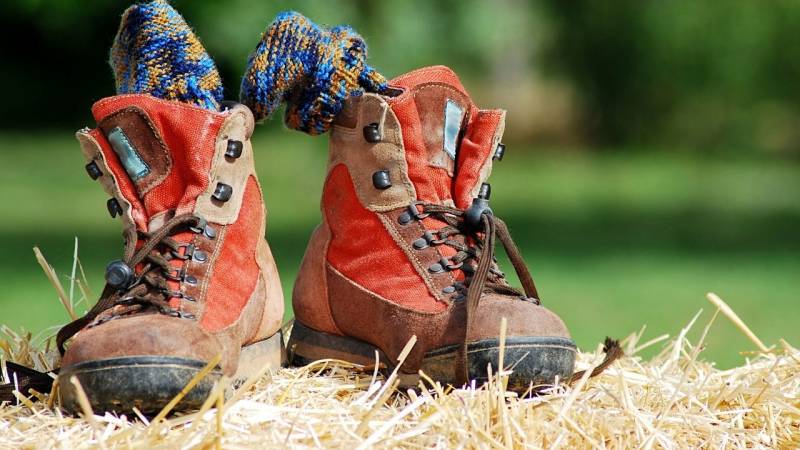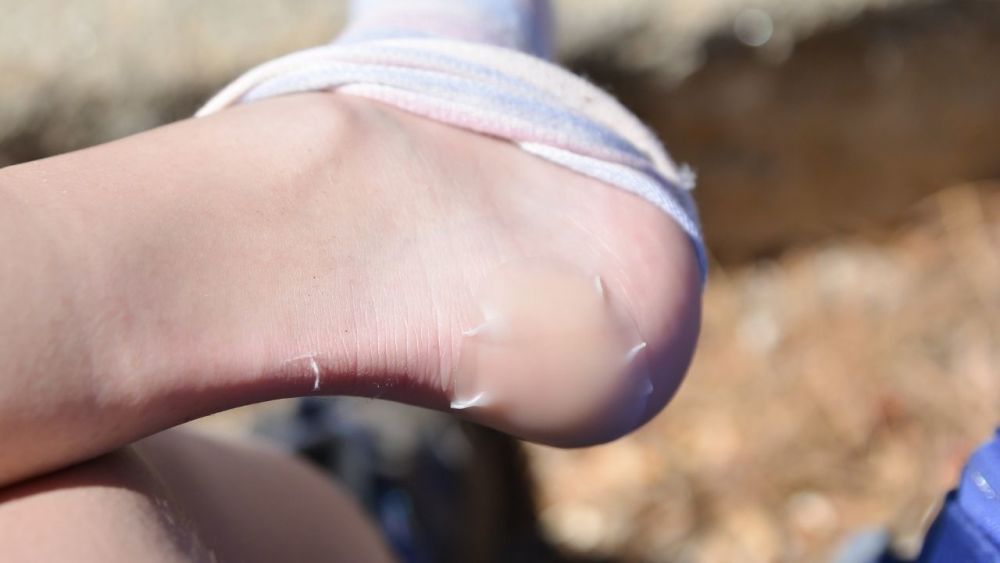
How do I avoid blisters when hiking and how do I successfully treat them?
👉 The key facts from this guide
- Wear the right shoes and buy them at a specialty store
- Choose the right socks, ideally made of merino wool
- Use insoles to optimize the fit of your shoes
- Keep your shoes and feet dry, for example by changing socks
- Keep your feet clean and use wet wipes for cleaning
- Treat emerging blisters immediately with blister plasters
You already wear hiking shoes, but you still can't avoid blisters?
Blisters bring down the mood while hiking.
It all starts with a slight pressure on the heel or toe, and before you know it, you have a painful and oozing blister that will accompany you throughout the long journey.
But it doesn't have to be that way because there are many ways to avoid blisters.
The best tips and tricks I want to give you today. Enjoy reading!
Why do we get blisters when hiking?
The main cause of the formation of blisters is ill-fitting shoes. When shoes are too big or too small, the skin of the feet starts to rub against the shoes, causing fluid to accumulate under the skin. This also happens with shoes that have an improper fit.

When hiking, we usually cover a lot of distance. Typically, we walk on rough paths and often uphill and downhill. This puts a lot of strain on our feet.
Those who wear the wrong shoes will soon have painful companions by their side. Blister formation is supported by moisture. This means that if you sweat a lot on your feet or your shoes are not water-repellent, the friction between skin and shoe increases.
Avoiding Blisters While Hiking - The Best Tips
Wear the right shoes
Hiking boots are not all the same. There are many models with various functions. First, you should know what kind of trails you plan to hike with the boots.
Do you prefer rocky, rugged, and steep terrain or do you prefer being in the forest? Depending on that, there are the right hiking shoes or boots, shoes with a soft or hard sole, or hiking boots for particularly alpine terrain.
Either way, it is always advisable to get your hiking boots from a specialty store. This way, you have the opportunity to try on the shoes and take them for a test walk. Additionally, an advisor will recommend the appropriate footwear and the right size for your foot and your activity.
If you do a lot of uphill and downhill walking, hiking boots are highly recommended. The high lacing relieves the foot and prevents sliding forward and backward.
One thing should be clear to you: Good hiking shoes are not cheap! Especially with shoes, you should not skimp. The money you don't invest in the shoes, you will have to invest in blister plasters in the future.

Wear the right socks
The choice of socks is often overlooked by most people. However, the right socks can make a huge difference when it comes to blister formation.
Avoid socks made of synthetic materials. These cause your feet to sweat quickly, leading to socks shifting and causing uncomfortable friction.
I also wore the wrong socks for a very long time. Once, by chance, I had socks made of merino wool on, and I noticed a big difference. The foot fits snugly in the shoe, so there is no friction.
In addition, merino wool is a natural material. This allows moisture to be absorbed much better. Another advantage of merino wool is that your socks won't smell.
You can wear your socks loosely for a week without them starting to smell. All you have to do is dry the socks and air them out a bit. By the way, there are many other articles made of merino wool for outdoor clothing.
Especially if you're traveling with just a van or a backpack, clothes made from this natural product are highly recommended.
Use Insoles
If you have owned your hiking shoes for a while, they are probably well broken in. However, this can eventually become a disadvantage. The constant wearing causes the material to stretch and the fit to change.
This can result in your feet rubbing against the shoes and causing blisters. However, you can prevent this by simply inserting insoles into your shoes. This reduces the extra space created.
However, be sure to choose the right fit. Another option for you are shoes from Salewa.
Hiking shoes from Salewa are equipped with an insole. You can replace it as often as you like, so you always maintain the perfect fit.
Keep your shoes and feet dry
An important point to protect your feet from blisters is to keep them dry. As mentioned before, wet feet cause even more friction and thus lead to more blister formation.
If you typically struggle with sweaty feet, you can try wearing socks made of merino wool. Otherwise, you need to make sure that your feet stay dry in other ways. Always bring spare socks with you and put them on when your other socks are already soaked.
This also helps if your shoes are not waterproof, and you get caught in the rain. If you are not only out in good weather, I recommend choosing shoes with a Gore-Tex membrane anyway. This way, you are always protected from wet shoes and feet in the rain.
Leggings can also help prevent water from entering the shoe.
Read also: Hiking in the Rain: What, Why, and How? 7 Tips to Make it Work!
Keep your feet clean
So that you can avoid blister formation as much as possible, you need to keep your feet not only dry but also clean. It's hard to avoid dirty feet while hiking. I always take off my shoes at the summit and let my feet breathe.

At times, I also walk barefoot. It's clear that my feet get dirty doing so. A similar problem arises when hiking through mud or sand.
Small dirt particles can get into the shoe and can therefore cause friction. You can also use gaiters to minimize the issue.
If you were walking barefoot, you should definitely clean your feet before slipping into your socks and shoes. Pay attention to the dirt between your toes as well. It's best to always have a few wet wipes with you.
So the dirt can be removed ideally. However, make sure to let your feet dry sufficiently again.
Prevent with band-aids and blister plasters
If you know that you will certainly get a blister during your hike, protect yourself with a blister plaster. I used to do that myself when I didn't have perfect hiking shoes yet.
Blister plasters are more recommended here than regular plasters. Regular plasters dissolve quickly or slip. Therefore, no protection is provided. They are also slightly thinner than blister plasters. Therefore, they do not offer such a large buffer.
Treat emerging blisters IMMEDIATELY
As soon as you notice a blister developing, you must not waste any time! Take a break and take off your shoes. Even if only a pressure point is visible at first, you need to treat the area.
If you don't act now, the condition will worsen. So now is the perfect time to apply a blister plaster to the area and maybe even change wet socks.

How to properly treat blisters
It can always happen that despite all the tips, blisters can form.
Everybody is different and therefore reacts differently to the strains of hiking. That's why I'm now giving you some advice on what you can do if blisters have already formed, and you want to prevent them from getting worse.
Use blister plasters
Everyone probably knows this tip and it's a good one! If you would like to keep going, it's essential to cover the blister to prevent bursting into tears from the pain. A blister plaster also prevents the formation of nasty infections.
By cushioning with the blister plaster, you prevent further friction at the site and the blister from getting bigger.

Open the bubble
I recommend this tip only to a limited extent, as there is a high risk of infection. However, sometimes it is necessary to open a blister. If a blister is extremely large, it also causes extreme pain.
If you happen to have a needle and some disinfectant with you, you can open your blister. However, be sure to stick a band-aid or blister plaster over the area afterward, otherwise all the effort will be in vain and friction will occur again.
Run barefoot
I have often struggled with blisters on many hikes. Often it got to the point where I simply couldn't continue. I had no choice but to continue barefoot.
However, walking barefoot must be practiced. If you never walk barefoot and then suddenly want or have to walk barefoot while hiking, it can be quite painful. This is because your feet have never had the opportunity to develop calluses.
However, I do not recommend taking off your shoes in very rough and alpine terrain. Sharp-edged stones could penetrate your feet, or you could twist your ankle and seriously injure yourself.
First Aid Kit for Blisters - What You Need to Have
A first aid kit should be carried by every hiker.
On any journey, it can happen that you or someone else gets seriously injured, and you have to administer first aid. But it's not just bandages and ice packs that you should have with you, but also various materials to treat blisters.
- Band-Aid
- Blister plaster
- Needle
- Disinfectant
- Change of socks
- Wound dressing
Questions and Answers (Q&A) on the Topic
What can I do if I have a blister but don't have any band-aids with me?
If you don't have any band-aids on hand, you'll need to provide some other padding. Perhaps you have another piece of clothing or an extra sock with you. Cut off a piece of it and wrap it around your foot. Otherwise, the only option is to go barefoot.
Can I go hiking again the next day with a blister on my foot?
Until a blister has healed, it takes a few days. However, you can still go hiking - provided you don't have severe pain. But be sure to cover the blister with a blister plaster.
My blister on my foot has burst. What should I do?
An open blister creates a high risk of infection. Take off your shoes as quickly as possible, disinfect the wound, and let air reach the wound. Do not use a blister plaster under any circumstances. Instead, use a regular plaster, as it is not fully equipped with adhesive material.


Author of the guide
Martin Gebhardt
Hey, I'm Martin. On my blog, you will learn the basics and numerous details about living in the wild. I think survival, bushcraft and the good life in nature are the keys to happiness. Find me here on Instagram or on YouTube. You can find more about my mission on the About Me page.
Was this guide helpful?
8 people found this guide helpful.
5.00 out of 5 points (8 Ratings)
Comments (0)
This post may contain affiliate links. So if you click on the links and make a purchase, I will receive a small commission at no additional cost to you. Click here, to learn more about it.


